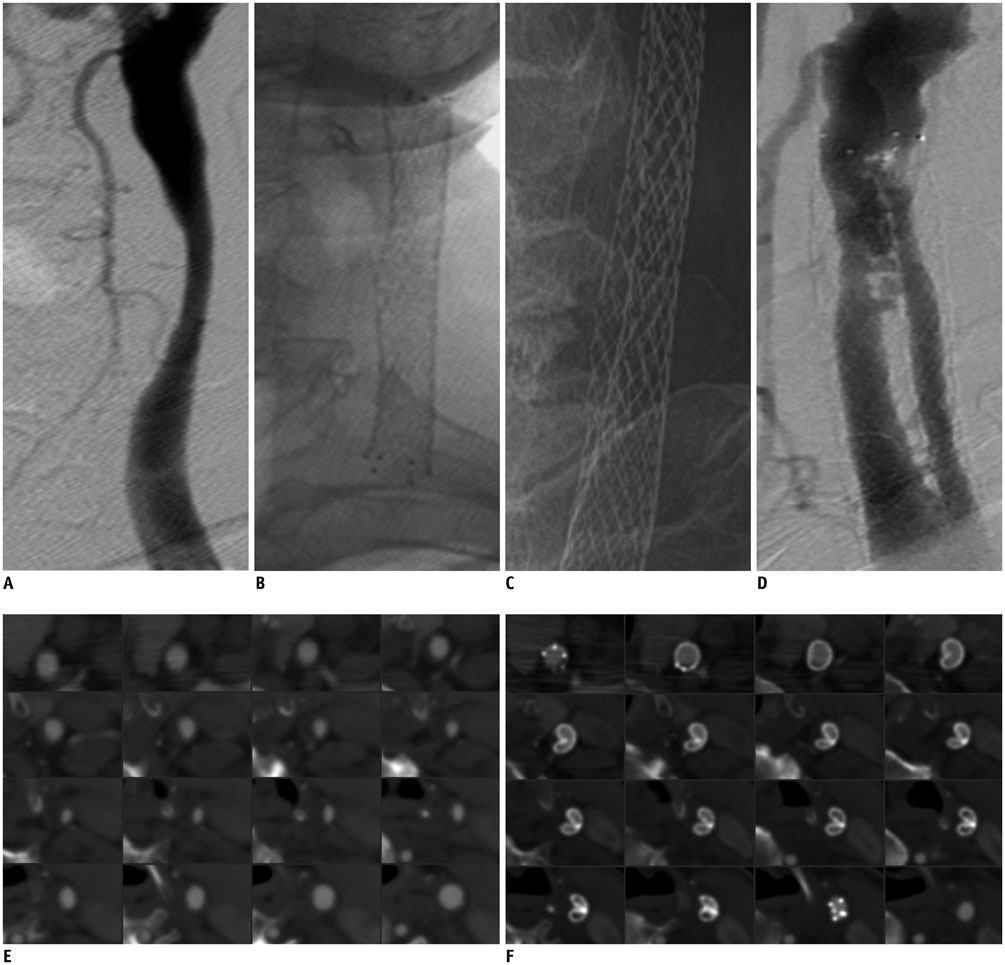Korean J Radiol.
2014 Dec;15(6):858-861. 10.3348/kjr.2014.15.6.858.
Delayed Cerebral Infarction due to Stent Folding Deformation Following Carotid Artery Stenting
- Affiliations
-
- 1Department of Neurology, Gangnam Severance Hospital, Yonsei University College of Medicine, Seoul 135-720, Korea.
- 2Severance Institute for Vascular and Metabolic Research, Yonsei University College of Medicine, Seoul 135-720, Korea. suhsh11@yuhs.ac
- 3Department of Radiology, Severance Hospital, Yonsei University College of Medicine, Seoul 120-752, Korea.
- 4Department of Radiology, Gangnam Severance Hospital, Yonsei University College of Medicine, Seoul 135-720, Korea.
- KMID: 1794660
- DOI: http://doi.org/10.3348/kjr.2014.15.6.858
Abstract
- We report a case of delayed cerebral infarction due to stent longitudinal folding deformation following carotid artery stenting using a self-expandable stent with an open-cell design. The stented segment of the left common carotid artery was divided into two different lumens by this folding deformation, and the separated lumens became restricted with in-stent thrombosis. Although no established method of managing this rare complication exists, a conservative approach was taken with administration of anticoagulant and dual antiplatelet therapy. No neurological symptoms were observed during several months of clinical follow-up after discharge.
MeSH Terms
-
Aged
Anticoagulants/therapeutic use
Carotid Arteries/radiography
Cerebral Infarction/*diagnosis/therapy
Humans
Male
Platelet Aggregation Inhibitors/therapeutic use
Stents/*adverse effects
Thrombosis/drug therapy/*etiology
Ticlopidine/analogs & derivatives/therapeutic use
Tomography, X-Ray Computed
Anticoagulants
Platelet Aggregation Inhibitors
Ticlopidine
Figure
Cited by 1 articles
-
Delayed Migration of Tapered Open-Cell Design Carotid Stent: A Case Report
Il Hyung Lee, Taedong Ok, Yo Han Jung, Kyung-Yul Lee, Sang Hyun Suh
Neurointervention. 2023;18(3):204-208. doi: 10.5469/neuroint.2023.00304.
Reference
-
1. Brott TG, Hobson RW 2nd, Howard G, Roubin GS, Clark WM, Brooks W, et al. Stenting versus endarterectomy for treatment of carotid-artery stenosis. N Engl J Med. 2010; 363:11–23.2. Chang CK, Huded CP, Nolan BW, Powell RJ. Prevalence and clinical significance of stent fracture and deformation following carotid artery stenting. J Vasc Surg. 2011; 54:685–690.3. Ling AJ, Mwipatayi P, Gandhi T, Sieunarine K. Stenting for carotid artery stenosis: fractures, proposed etiology and the need for surveillance. J Vasc Surg. 2008; 47:1220–1226. discussion 1226.4. Varcoe RL, Mah J, Young N, So SS, Vicaretti M, Swinnen J. Prevalence of carotid stent fractures in a single-center experience. J Endovasc Ther. 2008; 15:485–489.5. Coppi G, Moratto R, Veronesi J, Nicolosi E, Silingardi R. Carotid artery stent fracture identification and clinical relevance. J Vasc Surg. 2010; 51:1397–1405.6. Safian RD, Bresnahan JF, Jaff MR, Foster M, Bacharach JM, Maini B, et al. Protected carotid stenting in high-risk patients with severe carotid artery stenosis. J Am Coll Cardiol. 2006; 47:2384–2389.7. Sfyroeras GS, Koutsiaris A, Karathanos C, Giannakopoulos A, Giannoukas AD. Clinical relevance and treatment of carotid stent fractures. J Vasc Surg. 2010; 51:1280–1285.8. Robertson SW, Cheng CP, Razavi MK. Biomechanical response of stented carotid arteries to swallowing and neck motion. J Endovasc Ther. 2008; 15:663–671.9. Vos JA, Vos AW, Linsen MA, Marcus JT, Overtoom TT, van den Berg JC, et al. Impact of head movements on morphology and flow in the internal carotid artery after carotid angioplasty and stenting versus endarterectomy. J Vasc Surg. 2005; 41:469–475.10. Boehm G, Gschwendtner M, Schillinger M. Carotid stent fracture: diagnosis and management. Catheter Cardiovasc Interv. 2009; 74:273–277.11. de Vries JP, Meijer RW, van den Berg JC, Meijer JM, van de Pavoordt ED. Stent fracture after endoluminal repair of a carotid artery pseudoaneurysm. J Endovasc Ther. 2005; 12:612–615.
- Full Text Links
- Actions
-
Cited
- CITED
-
- Close
- Share
- Similar articles
-
- Contralateral Cerebral Infarction after Stent Placement in Carotid Artery : An Unexpected Complication
- Percutaneous Transluminal Angioplasty with Palmaz-Schatz Stent in the Carotid Artery Stenosis
- Superficial Temporal Artery-Middle Cerebral Artery Anastomosis for Internal Carotid Artery Occlusion by Subacute In-Stent Thrombosis after Carotid Artery Stenting
- Bilateral Superior Cerebellar Artery Infarction after Stent-Angioplasty for Internal Carotid Artery Stenosis
- How to Escape Stentriever Wedging in an Open-cell Carotid Stent during Mechanical Thrombectomy for Tandem Cervical Internal Carotid Artery and Middle Cerebral Artery Occlusion


